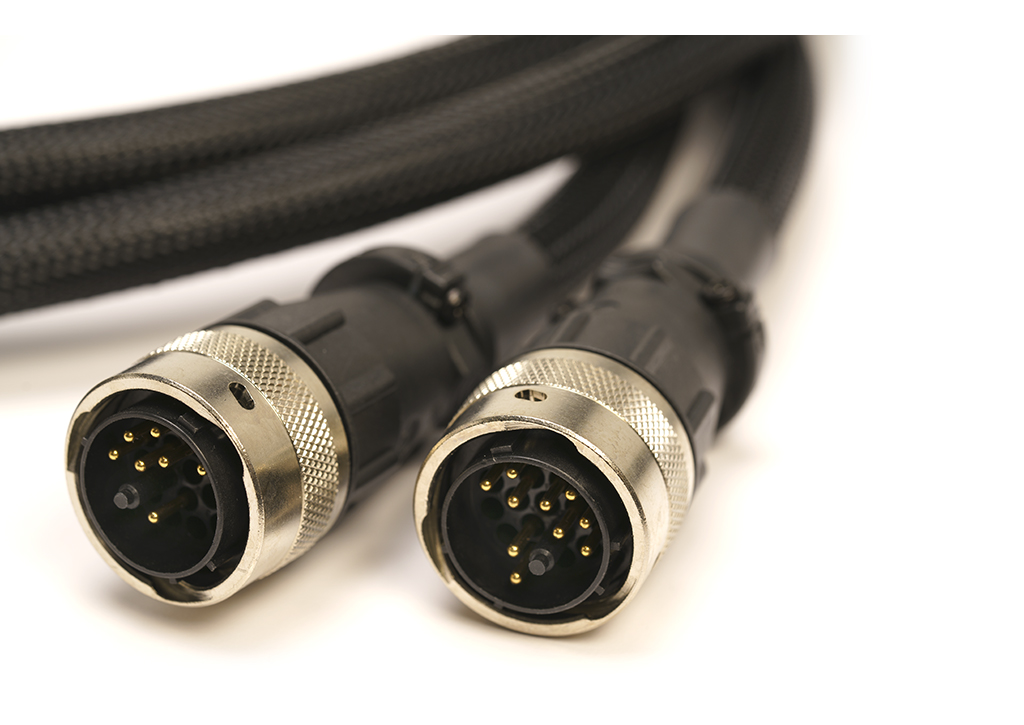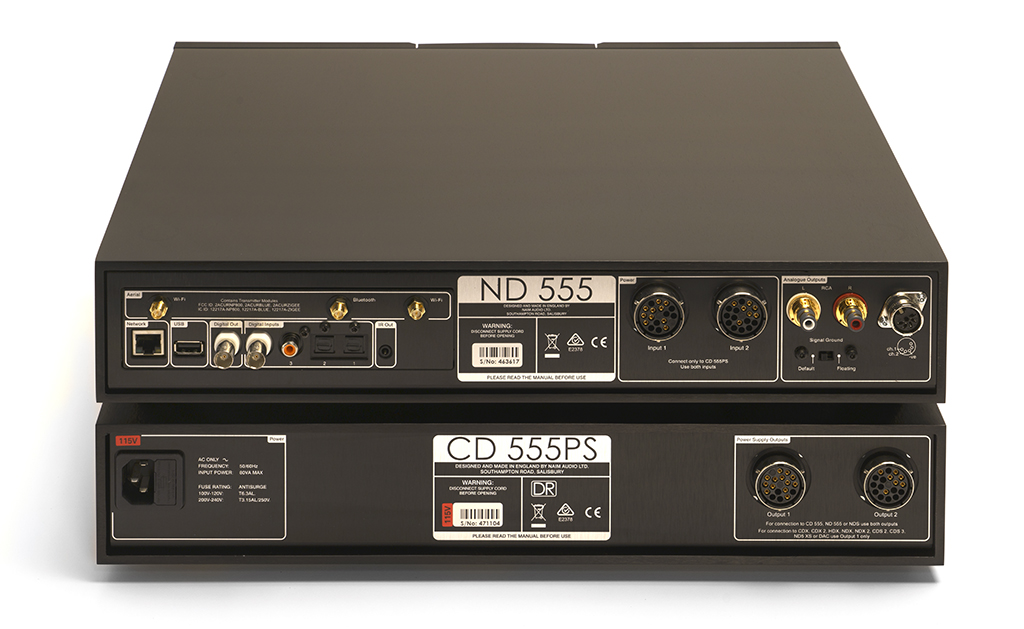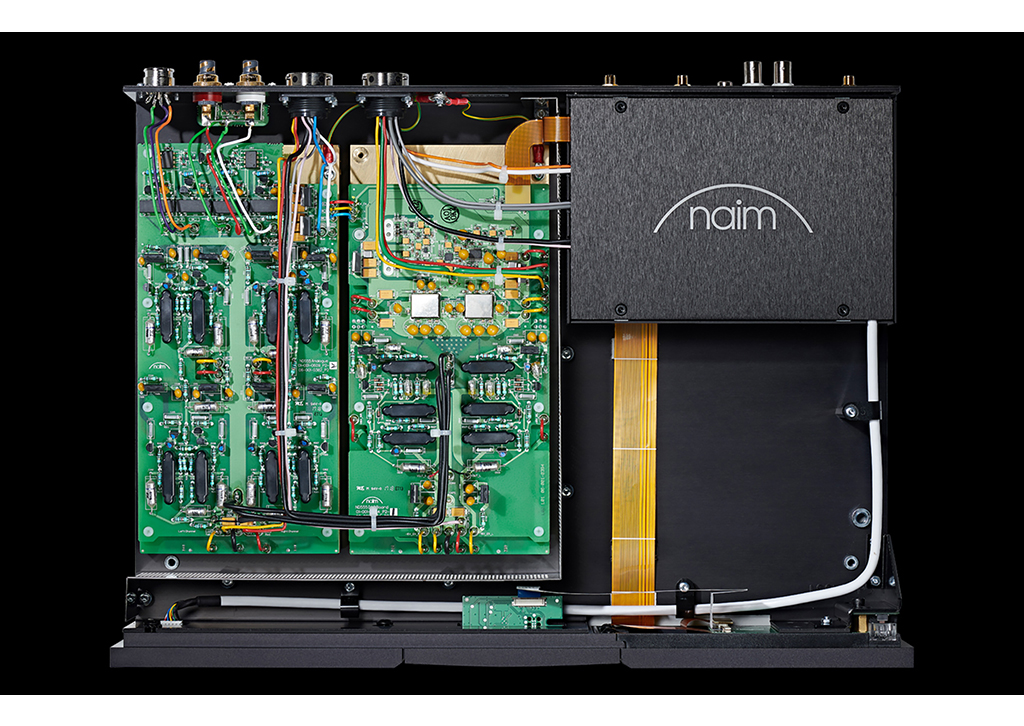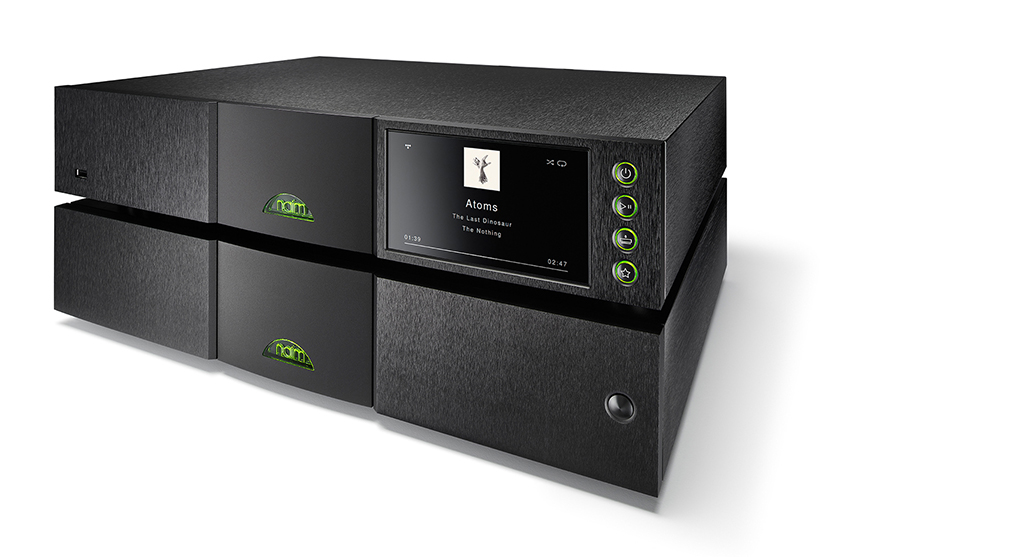REVIEW: Naim ND555DAC and PS555 Power Supply A supreme DAC/Streaming option for your digital files
By Jeff Dorgay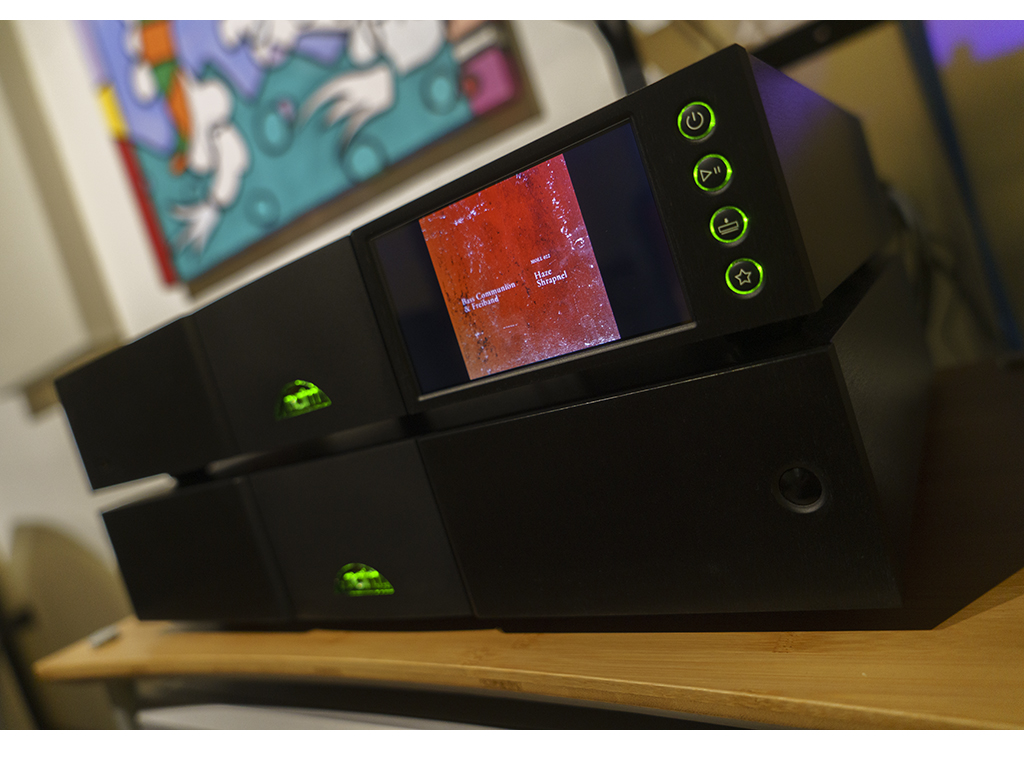 If you are considering adding Naim’s top digital streaming DAC to your system, and if by some chance you are not fully integrated into the Naim way of doing things, please read the instructions first. This is not a plug-and-play device.
If you are considering adding Naim’s top digital streaming DAC to your system, and if by some chance you are not fully integrated into the Naim way of doing things, please read the instructions first. This is not a plug-and-play device.
Our reviews don’t usually start with such a stern note (we’re the fun hifi people, after all), but it’s really critical to get this player installed in a specific way to get it to work correctly. As with so many of us, there are two ways to do things, ours and some other way. Serious Naim enthusiasts stay within the Naim ecosystem of SNAICs, Burndys, and such. If you are so equipped, you’ll be able to use the supplied premium Naim interconnects and plug them right into your system.
Unpack and setup
Here’s some setup advice for the rest of you that won’t read the damn manual. Download and follow the quick start guide from the Naim website to the letter. This means unscrewing the four transit screws that keep the DAC board floating. Do NOT tip the ND555 up vertical to do this – hold it over a counter or shelf top and quickly unscrew all four of these, then very gently move the ND555 into place. Take the 4 transit screws, put them in a Ziplock bag, and toss them back into the ND555 box, in case you move or need service. You’ll thank me for this in about 8 years.
Next, remove the two Burndy cables from the accessory box and take careful note that one of them has a single red stripe, and the other has two green stripes underneath the black sheath covering the cables. These correspond to output 1 and output 2 on the PS555 that connect to the same inputs on the ND555. Another tip from a long-term Naim owner – these cables have a plastic index pin in the pin matrix that is easily broken (ask me how I know this), so very carefully align this pin and gently insert the power supply connector into its socket. The outer, locking collar will then twist into place solidly. Again, gentle is the word. Now you’re ready to power it up, power supply first, and then the ND555. Follow the prompts on the crisp LED screen, and you’re almost there.
The one thing not in the quick start guide
Integrating the ND555 into your non-Naim system requires a pair of RCA interconnects. If your ND555 makes no sound, even though it appears to be playing, you need to go back to the app to make this change. There is no way to access this via the front panel and remote. Go to “Settings,” then “Output Settings,” then choose RCA.
While in here, you can also fine-tune the appearance of the app, and whether you’d like fixed or variable output levels. This is incredibly handy because if you are a digital-only person with no intention of spinning records, while the ND555 offers a variable output, Naim suggests that this is a digital volume control to be used with some streaming services like AirPlay. Naim’s Steve Sells says, “we strongly recommend a true analog preamplifier for best sound quality.”
A plethora of inputs at your disposal
The ND555 works with a vast range of digital sources. It’s a Chromecast device, it works with Tidal, Qobuz, Spotify, internet radio, and of course, our favorite – it’s a Roon endpoint too. Integrating the ND555 into our Roon network took less than a minute, but if you are not a Roon user, the Naim music app is very good. If you only have a few thousand selections in your music library and don’t want another subscription, the Naim app is convenient to use.
You will need a single PS555 power supply to operate the ND555, but like the CD555, you can use a pair of them to get even more sonic excellence. Where dCS and Esoteric give you the option to add an external master clock (and in the case of dCS, an additional outboard upsampler), Naim offers increased performance by providing additional power supply capacity. This is a known upgrade path with their gear that works incredibly well.
We did not ask Naim for a second PS555, but having used one with the CD555 when it was a reference component, the improvement was dramatic enough that the genuinely obsessed will want to budget for one at some point. Perusing the Naim forum, the owners who have taken the plunge all seem happy with the choice and indicate a similar resolution and dynamic improvement as we noticed with the CD555. Rest assured that if your check writing fingers are tired after writing the big check, you’ll still have a ton of fun with the single power supply version.
It’s also worth mentioning here, that like the CD555/PS555, the ND555/PS555 is the only digital player along with our reference dCS Vivaldi One that does not benefit from additional power conditioning. You can plug this baby into the wall with the supplied premium Naim mains cord (which looks and feels like a mains cord you’d probably spend about 2 or 3 grand with somewhere else – nice touch) and forget about it. That’s impressive.
Finally, pair the remote, download the Naim app to your mobile device of choice, and make the necessary connections. Gone is the posh billet remote from the CD555, but this is still a friendly remote control that gives you access to most ND555 functions. The ultra-crisp front panel display is not a touch screen, and honestly, in a premium player like this, display quality outweighs a little bit of functionality. Plus, it would look oh so unsightly to have your 32 thousand dollar Naim streamer full of fingerprints.
Off you go
At this point, you are ready to start listening to music, but there’s still a bit of a delay to get the 555 combo’s full dose of excellence. Those big power supply capacitors take a little while to get their groove on. The first hour or two of the 555s listening, you might be shaking your head and in a David Byrne kind of way think, “my God, what have I done?” These two boxes sound harsh and flat at initial power-up. But don’t panic – the good stuff is on the way.
If we weren’t still living in a travel-restricted, COVID unfriendly world, I’d tell you to put the 555s on repeat and take a couple of day holiday. So, if you can ignore the sound coming out of these Naim boxes for about a week of play, it will improve tremendously. For those skeptical of the burn-in process, listening to the same two or three tracks every day at the beginning of your listening session will convince you. Even solid-state components need a certain amount of time to fully stabilize thermally, so if you can leave your 555s on all the time, they will stay right at the optimum point.
Serious listening
With that out of the way, the ND555 is truly brilliant. A digital front end at this level should have no shortcomings in playback or operation, and the ND555/PS555 does not. Nothing. I’ve been fortunate enough to live with this player for the better part of a year, and once you wiggle through the setup maze, sitting back and listening is terrific.
While we’re ticking boxes, this is the point in the review, where the product in for review is compared to the long-term reference and is found to come up slightly short. Regular readers might be thinking, “how does it compare to the dCS?” Fantastic, but different. Here are a few comparisons, which will hopefully resonate on one level for you.
Comparing these two players is like choosing between a Porsche 911 Turbo S and the 911 GT3. Both are stunning performers, but the way they present the experience is entirely different. The Turbo S has more power, features all-wheel drive, and uses Porsche’s PDK, dual-clutch automatic transmission. The GT3 offers a normally aspirated motor with a 9,000 rpm redline, rear-wheel drive, and 6-speed manual gearbox. Which would you choose? Do you want to feel everything when going fast, or would you rather have a bit bigger, broader, weightier experience? This is the difference between the Naim and the dCS.
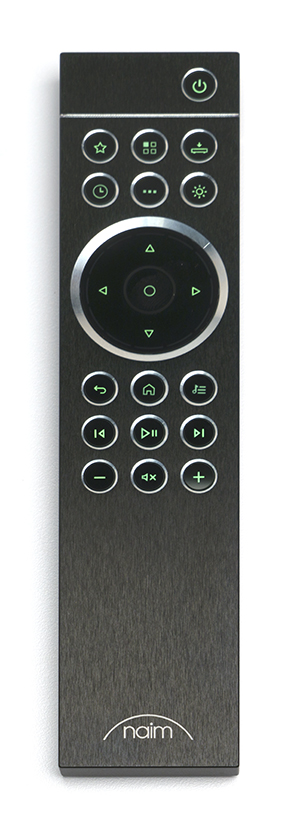 The Vivaldi has slightly more weight and dynamic heft, with a slightly smoother top end, where the Naim offers a bit more inner detail and offers the slightest touch of extra dynamic contrast that the dCS does not. If you have the roads and the access to track time, nothing but the GT3 will squeeze your adrenaline gland that hard. However, if you’re driving your 911 everywhere, you’ll appreciate the extra comfort the Turbo S brings. What is the best? Only what suits your needs the best.
The Vivaldi has slightly more weight and dynamic heft, with a slightly smoother top end, where the Naim offers a bit more inner detail and offers the slightest touch of extra dynamic contrast that the dCS does not. If you have the roads and the access to track time, nothing but the GT3 will squeeze your adrenaline gland that hard. However, if you’re driving your 911 everywhere, you’ll appreciate the extra comfort the Turbo S brings. What is the best? Only what suits your needs the best.
Those of you that are at the pinnacle of analog might relate to this comparison more… The dCS feels more like a Clearaudio Goldfinger, and the Naim reminds me a lot more of a Lyra Etna. Or, if you remember film photography, the dCS is Kodachrome, and the Naim is Fujichrome. What does all this mumbo jumbo mean? Glad you asked.
Where the dCS sounds fantastic with everything played (In all fairness, the Vivaldi One is an SACD player, so consider the comparison to the Vivaldi DAC, which is similarly priced to the ND555/PS555.) when switching back and forth between it and the Naim, the Naim gets the edge pulling the most detail out of perfect recordings. However, when the road gets a little bumpier, the dCS is a comfier ride. This is a fine distinction, and depending on the overall tonal balance of your system might not even matter.
For example, when listening to a handful of Monkees’ tracks, or to be more current, nearly anything from Jack White is a bit grating through the Naim. Not unlistenable, but grating. These are dreadful recordings, to be sure, and in the end, reminiscent of early digital players. Switch up the playlist to some exceptional recordings, and the Naim never disappoints. And, the Naim’s awesomeness is not limited to high-res recordings. Just like the CD555, the ND555 proves that there is a lot of music happening in well-recorded 16/44 tracks.
It would be easy to wax poetic about how great Patricia Barber or Louis and Ella sound through this player… that’s just low hanging fruit. Those feeling a little more adventuresome or avant-garde may even enjoy the latest, Frank Zappa, high res releases on Qobuz. “Don’t Eat The Yellow Snow” has been a favorite since college days, yet playing Apostrophe through the Naim player is a revelation. Frank Zappa built a reputation for complex, densely packed music, full of the tiniest musical nuggets that often require headphones and trendy chemical amusement aids to uncover. The ND555 goes deeper into this mine than ever, and it’s an incredible, engaging experience. This is what you write the big check for.
Specs, tech, and functionality
Even after a lengthy review like this, there is still more we haven’t unearthed. We suggest revisiting the Naim website and even the Naim forum, where you can get a healthy dose of unfiltered comments from ND555 owners. I’ve always enjoyed the Naim forum and have found excellent tech advice there over the years.
The final argument that can be had about the Naim and its Burr-Brown based chipset vs. the shortlist of DACs that do it all in software is the question of earlier obsolescence because a chipset-based digital decoder will obviously become obsolete faster than one that can merely have new software and firmware uploaded.
In an ultimate sense, this is true; however, the ND555/PS555 (especially if you go for broke and add a second PS555) is so good, I can’t imagine digital playback getting all that much better. At least not to the point that you’d want to scrap the ND555. Had computer audio and streaming not hit the scene, the CD555/PS555 would still be my digital reference. For all but the most ADD, this one should last you a lifetime.
If you tick the yes box
If you like what we’ve had to say so far, and you are looking for a destination digital front end, the next step is to make an appointment with your Naim specialist so you can see for yourself (and hear, of course) how lovely the ND555/PS555 is.
The biggest question of all is: is the ND555 “worth the money?” While that is always a relative question, and there are thousands of people on the internet that will tell you spending this much money on a DAC is insanity.
However, if you’ve got $40k in available funds, you A: aren’t sweating how to pay this month’s mortgage payment, and B: you’ve probably worked your way up the audiophile ladder a bit, and my hope is that you’ve heard many of the other offerings. There are a lot of great DACs in the $9,000 – $15,000 arena (even from Naim and dCS). After auditioning and living with a number of those, if you can make the jump, the level of musicality and ease that the ND555 creates is worth every penny. And as I like to say, if you can take the big leap now, you won’t lose $2k-$5k each time you trade up from a lesser DAC. It adds up in a hurry.
Yes, build quality at this level is superb, and of course, thousands of hours of research, testing, and prototyping went in the front door. But in the end, when you compare the finest DACs at this price point as a whole, they still outperform the DACs a click or two down. Finally, when you graduate to a player at this level, there is no more regret. You won’t find yourself sitting in the listening chair pondering, “if it only did a little more of this, or a little less of that.” Build quality, execution, ergonomics, and most of all, sound quality are all top. Another thought to ponder: because Naim can build a product at this level makes their entry-level digital products equally compelling. There’s a deep pool of knowledge to swim in, so even if you can’t play at the top of the mountain, it’s still a good day wherever you can be. Naim makes a fantastic $3k player because they have the engineering chops to make a $40k player.
Naim digital players are at the top of the mountain when capturing music’s pace and timing. There is a correctness here that is achieved by precious few digital players, and when listening to acoustic instruments, everything in the mix feels as if it’s the proper size and has correct spatial relationships. Some players can feel overblown, yet with the ND555, you can hear the difference between an upright Steinway and a Grand. This level of musicality will have you looking at your turntable, wondering if you really need to fuss with vinyl anymore. It’s that good.
Peripherals
Preamplifier Pass Labs XS Pre
Analog Pass Labs XS Phono, Grand Prix Parabolica, Lyra Atlas
Power Amplifier Pass Labs XA200.8
Speakers Sonus faber Stradivari, six-pack of REL no.25 subwoofers
Cable Cardas Clear, Tellurium Q, and Red Miracle interconnect
(Naim to preamplifier)




